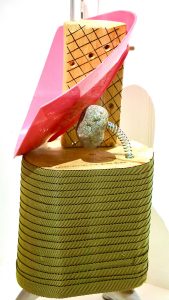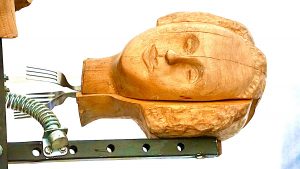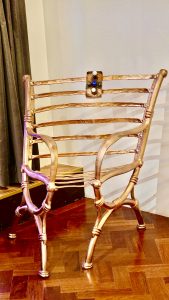
The Sound Before The Bird Sings, sculture by Hugh Tessier, credit Antiche Curiosità©
Mary Blindflowers©
(Translator Mariano Grossi©)
Hugh Tessier, arte non business
.
Stevenage, nato come villaggio sassone, nell’Hertfordshire del VII secolo, non è oggi uno di quei posti consigliati dalle agenzie di viaggi. Agli inizi dell’Ottocento Stevenage era ancora molto piccola.
Non ha particolari attrattive per il turismo.
Oltretutto negli anni 50 ha avuto uno sviluppo urbano incontrollato, non proprio esteticamente gradevole.
Un centro piuttosto piccolo, strada lunga con negozi, ristoranti e case a destra e a sinistra.
Attorno al centro si aprono i quartieri popolari.
Il parco è carino ma abbastanza sporco.
Vicino c’è un museo molto piccolo ospitato dentro una parte di una chiesa dall’architettura discutibile e antiestetica.
Giorni fa mi trovo a passare di là per caso e, sempre per caso, sono entrata al museo. Ingresso gratuito. All’ingresso c’è un negozietto pieno di cose perlopiù inutili difficili anche da vedere perché posizionate dietro un vetro.
Nei giorni in cui sono andata, c’era anche una esibizione d’arte dal titolo Curiosity, autore Hugh Tessier.
L’esibizione devo dire è stata la parte più interessante del museo. Tessier rappresenta una razza quasi estinta di artista a tutto tondo che recupera materiali vari, rame, legno, tubi di plastica, ferro battuto, vecchie sedie, materiale elettrico, etc. per creare vere e proprie opere d’arte, sottilmente simboliche e metaforiche, sculture curiose e piene di genio creativo.
È dunque valsa la pena di entrare al museo soltanto per vedere la sua esibizione.
Non soltanto Tessier sa stupire con il concetto sotteso alla sua arte, ma ha una concezione etica della stessa. Mi ha spiegato che per lui è giusto che l’arte non sia soltanto un feticcio per classi ricche che possono permettersi di pagare forti somme di denaro per averla, bensì dovrebbe essere patrimonio di tutti, anche dei poveri. Così, di recente, ha creato una charity in cui il concetto è che se fai un’offerta per la charity puoi avere una delle sue opere d’arte.
Lontano dai clamori dell’arte come business, dunque l’artista si dedica all’arte per l’arte e la sua diffusione anche tra le classi popolari:
“My work explores the abundance of things usually discarded or rejected, to find new purpose and meaning. Curiosity is describing my journey and I hope you will enjoy trying to see the light and the bite buried out of sight.
The Arts have a vital role in our society to enrich, to play, to laugh and sing, it should not be an exclusive luxury but an inclusive expression of love of living.
The pandemic has exploded into our lives imposing massive restrictions and suffering yet some good things like the NHS, like the community pulling together to fight for our lives proves our motto: ‘The Heart Of Our Town Lies In Its People’.
The Stevenage Museum has been shut to visitors since lockdown along with all leisure services in our town so the opportunity at reopening with a curiosity show in our museum was just too good to miss”.

Jouissance, sculpture by Hugh Tessier, credit Antiche Curiosità
Da materiali di recupero nasce il Joy Throne, una sedia in rame talmente stretta che è impossibile sedercisi, sottile metafora dell’irraggiungibilità di certa stabile felicità terrena, o l’autoritratto, una testa in legno ma al rovescio, come a sottolineare l’importanza di pensare “al contrario”, secondo un moto opposto a quello ordinario, oppure Jouissance, fatta di rame, luci blu e colini in metallo per cuocere le verdure che ricorda vagamente una figura umana stilizzata che si accende, di gioia, appunto. The Sound Before The Bird Sings, costruita con vari materiali, legno, plastica, pietra, metallo, è sottilmente poetica.
Lo studio di Tessier che ho avuto occasione di visitare, è un laboratorio di curiosità. Là ho visto anche un’opera che il museo non ha voluto esporre perché ritenuta “troppo forte” per i canoni tradizionali e i valori dominanti. Tre teste in legno di cui due colpite dai coltelli, appoggiate su un supporto metallico.
L’idea che l’arte non sia solo un business dovrebbe essere alla base di ogni sana creazione artistica e il museo forse dovrebbero capire che seguire la linea del politicamente corretto per l’arte non ha troppo senso perché l’arte è arte, libera creazione, non ha il compito di seguire i valori tradizionalmente imposti dalla società, anzi può perfino superarli.

Sculpture by Hugh Tessier (detail), credit Antiche Curiosità©
.
Hugh Tessier, art not business
Stevenage, born as a Saxon village, in VII century’s Hertfordshire, today is not one of those places recommended by tour agencies. In the early 1800s Stevenage was still very small.
It does not possess special amenities for touring.
Besides in the fifties it got an uncontrolled urban development, not quite pleasant as for aesthetics.
A rather small centre, a long street with shops, restaurants and houses left and right.
Around its centre working-class districts open.
Its park is lovely, but dirty enough.
Close to it there is a very small museum housed inside a part of an objectionable and unsightly church as for its architecture.
Days ago I was just passing by and, always by chance, entered the museum. Free entrance. At the door there is a small shop full of quite useless things very hard to see since they are located behind a glass.
During the days when I went to its museum, there was also an art exhibition whose name was Curiosity, and its author was Hugh Tessier.
I must state that the exhibition was the most interesting section of the museum. Tessier represents an almost died out race of all-round artist who recovers various stuffs, copper, wood, plastic pipes, wrought iron, old chairs, electrical equipment, and so on to create subtly symbolic and metaphoric real artworks, curious sculptures which are full of creative genius.
Therefore entering the museum has been worthwhile just to see its exhibition.
Not only can Tessier amaze with the concept underlying its art, but he has got an ethic conception of it too. He explained to me that for him it is right that art is not just a fetish for the wealthy classes who can afford to pay large sums of money to get it, but it should belong to everyone, to the poor too. So, recently, he has created a charity whose concept is the following: provided you give the charity a donation, you can get a work of art of his. Far off from the clamour of art as a business, so the artist engages in the art for the art and its spread among popular classes too:
“My work explores the abundance of things usually discarded or rejected, to find new purpose and meaning. Curiosity is describing my journey and I hope you will enjoy trying to see the light and the bite buried out of sight.
The Arts have a vital role in our society to enrich, to play, to laugh and sing, it should not be an exclusive luxury but an inclusive expression of love of living.
The pandemic has exploded into our lives imposing massive restrictions and suffering yet some good things like the NHS, like the community pulling together to fight for our lives proves our motto: ‘The Heart Of Our Town Lies In Its People’.
The Stevenage Museum has been shut to visitors since lockdown along with all leisure services in our town so the opportunity at reopening with a curiosity show in our museum was just too good to miss.”

Joy Throne, sculpture by Hugh Tessier, credit Antiche Curiosità©
From recycled materials is born the Joy Throne, a copper chair so narrow that to sit there is impossible, a subtle metaphor of the unattainability of a certain stable earthly happiness, or the self-portrait, a wooden head, but upside-down, as to underline the relevance of thinking “conversely”, following a motion which stands against the ordinary one, or Jouissance, made of copper, blue lights and metal strainers to cook vegetables, which vaguely recalls a stylized human figure which lights up, with joy, indeed. The Sound Before the Bird Sings, built by various stuffs, wood, plastic, stone, metal, is subtly poetic.
Tessier’s studio, which I has got the chance to visit, is a cabinet of curiosities. There I saw an art-work as well the museum refused to show since they deemed it “too strong” for traditional features and ruling values. Three wooden heads and two of them hit by knives, resting on a metal support.
The idea art is not just a business should be the basis of every sound art creation and maybe at the museum someone should realize that following politically correct’s idea cannot make too much sense as art is art, free creation, does not have the task of following the values traditionally imposed by society, indeed, on the contrary, it can even overcome them.
.
DESTRUTTURALISMO Punti salienti

